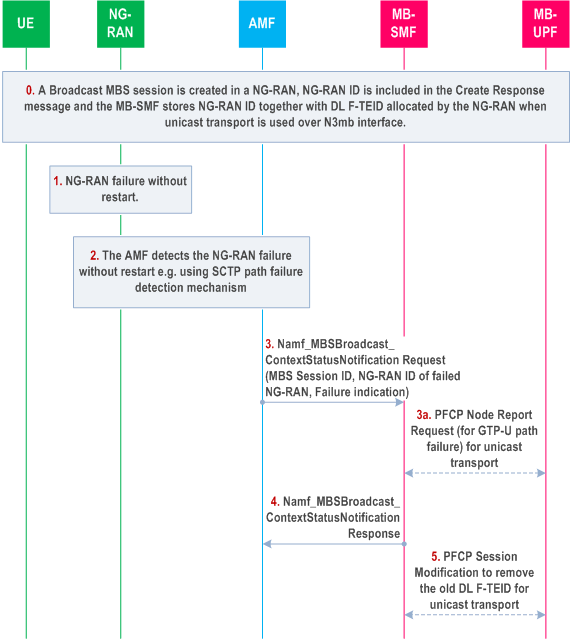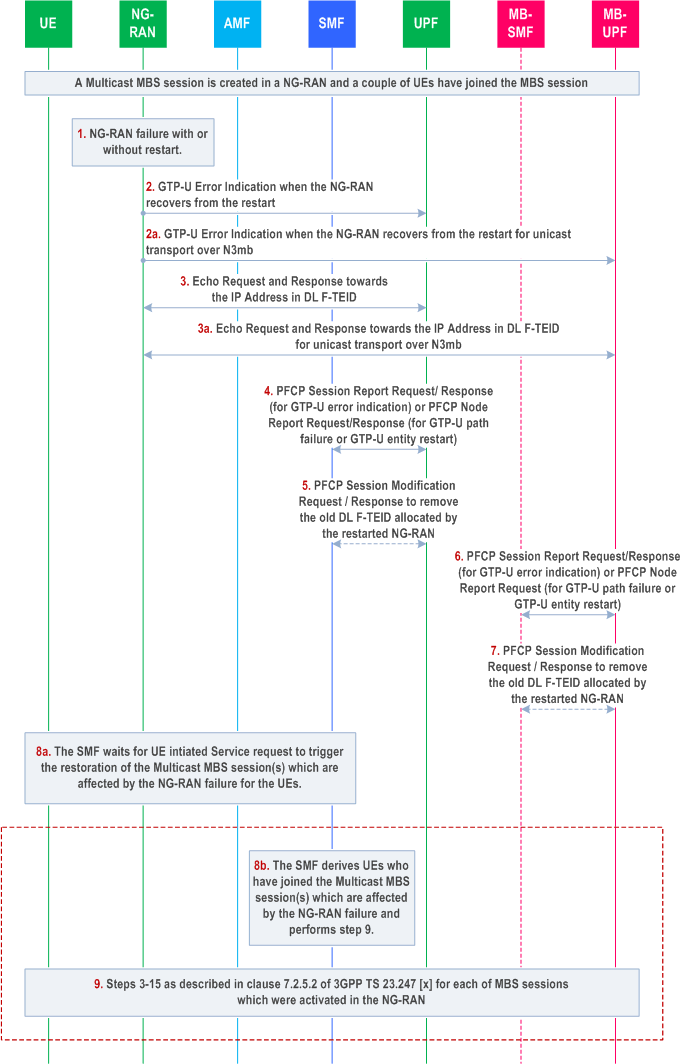Content for TS 23.527 Word version: 19.0.0
8.3.3 Broadcast MBS session restoration Procedure for NG-RAN failure without restart
8.3.4 Multicast MBS session restoration Procedure for NG-RAN failure with or without restart
...
...
8.3.3 Broadcast MBS session restoration Procedure for NG-RAN failure without restart p. 46
The procedure specified in this clause may be supported to restore a Broadcast MBS session affected by an NG-RAN failure without restart.
When the AMF detects NG-RAN failure without restart, e.g. using SCTP path failure detection mechanism, it shall report such event to the MB-SMF for each of MBS session(s) affected by this failure, to enable the MB-SMF to remove the DL F-TEID allocated by the failed NG-RAN in the MB-UPF when unicast transport is used over N3mb interface.

Step 0.
A Broadcast MBS session is created in a NG-RAN, the NG-RAN ID is inserted by the AMF in the N2MbsSmInfo attribute included in the Namf_MBSBroadcast_ContextCreate Response message to the MB-SMF and the MB-SMF stores the NG-RAN ID together with the DL F-TEID allocated by the NG-RAN when unicast transport is used over N3mb interface.
Step 1.
The NG-RAN has failed without restart.
Step 2.
The AMF detects the NG-RAN has failed without restart e.g. using SCTP path failure detection mechanism.
Step 3.
The AMF sends Namf_MBSBroadcast_ContextStatusNotify Request message to the MB-SMF for each affected MBS session including the MBS Session ID, the NG-RAN ID and an indication of the NG-RAN failure without restart event.
Step 3a.
The MB-SMF receives a PFCP Node Report Request message from the MB-UPF to report NG-RAN has failed without restart for each affected MBS session when unicast transport was used for N3mb interface.
Step 4.
The MB-SMF returns a "204 No Content" response.
Step 5.
The MB-SMF modifies the PFCP sessions corresponding to the affected MBS sessions to remove the NG-RAN DL F-TEID in case NG-RAN failure without restart for unicast transport over N3mb.
The MB-SMF executes step 5 upon receiving either the notification from the AMF or from the MB-UPF.
If the restoration procedure is triggered due to notification from AMF as specified in step 3, this step may be skipped in deployments where multiple NG-RAN nodes share a common user plane entity, unicast transport is used over N3mb, and the MB-SMF that supports handling shared NG-U terminations determines that the DL F-TEID is associated with other NG-RAN nodes too.
8.3.4 Multicast MBS session restoration Procedure for NG-RAN failure with or without restart p. 47
The procedure specified in this clause may be supported to restore a Multicast MBS session affected by an NG-RAN failure with or without restart.
When a UPF detects the NG-RAN failure with or without restart using Echo Request and Echo Response message which is sent towards the IP address in the DL F-TEID allocated by the failed NG-RAN, or upon receiving GTP-U Error Indication, it shall report such event to the SMF to enable the SMF to derive UEs who have joined the MBS sessions which are affected by the NG-RAN failure and initiates the restoration procedure for each of Multicast MBS session which were activated in the failed NG-RAN as described in Figure 8.3.4-1.
When unicast transport is used over N3mb interface for 5GC Shared MBS traffic delivery, the MB-UPF detects the NG-RAN failure with or without restart using Echo Request and Echo Response message which is sent towards the IP address in the DL F-TEID allocated by the failed NG-RAN, or upon receiving GTP-U Error Indication, it shall report such event to the MB-SMF, so that the MB-SMF removes the DL-TEID allocated by the failed NG-RAN.

Step 1.
The NG-RAN has failed with or without restart.
Step 2.
The UPF receive GTP-U Error Indication when the NG-RAN recovers from its restart for 5GC Individual MBS traffic delivery.
Step 2a.
The MB-UPF receives GTP-U Error Indication when the NG-RAN recovers from its restart for unicast transport over N3mb for 5GC Shared MBS traffic delivery.
Step 3.
The UPF sends Echo Request message towards the NG-RAN using the IP address included in the DL F-TEID, thus the UPF detects the NG-RAN has failed with or without restart.
Step 3a.
The MB-UPF sends Echo Request message towards the NG-RAN using the IP address included in the DL F-TEID for unicast transport over N3mb, thus the MB-UPF detects the NG-RAN has failed with or without restart.
Step 4.
The UPF sends PFCP Session Report Request messages to the SMF to report receiving of GTP-U Error Indication message, or sends a PFCP Node Report Request message to the SMF to report the GTP-U path failure towards the NG-RAN or the remote GTP-U entity has restarted.
Step 5.
The SMF sends PFCP Session Modification Request message to request the UPF to remove DL-FTEID allocated by the failed NG-RAN and buffer the MBS session data for 5GC Individual MBS traffic delivery, except for an NG-RAN restart if the UPF has already removed the DL F-TEID on its own as specified in clause 5.5.
Step 6.
The MB-UPF sends PFCP Session Report Request messages to the MB-SMF to report receiving of GTP-U Error Indication message, or sends a PFCP Node Report Request message to the MB-SMF to report the GTP-U path failure towards the NG-RAN or the remote GTP-U entity has restarted, for unicast transport for N3mb.
Step 7.
The MB-SMF sends PFCP Session Modification Request message to request the MB-UPF to remove DL-FTEID allocated by the failed NG-RAN, except for an NG-RAN restart if the MB-UPF has already removed the DL F-TEID on its own as specified in clause 5.5.
Step 8a.
The SMF may wait for UEs who have joined the MBS session(s) which are affected by the NG-RAN failure to trigger a Service Request procedure to re-establish the user plane resource and then restore the Multicast MBS session in NG-RAN.
Step 8b.
Alternatively, the SMF may derive UEs who have joined the MBS session(s) which are affected by the NG-RAN failure (i.e. with a DL F-TEID matching the IP address of the NG-RAN node's to restore the MBS service and perform step 9.
Step 9.
When step 8b applies, the SMF continues with the MBS session activation procedure as specified in clause 7.2.5.2 of TS 23.247 starting from step 3 to restore the MBS sessions for affected UEs for each MBS session.